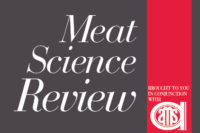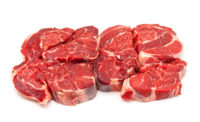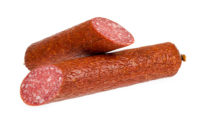HPP was found to be an effective intervention against Escherichia coli O157:H7in ground beef. However, very little information has addressed the effect of HPP on other Shiga-toxin producing E. coli (STEC), including E. coli O145, O26, O45, O103, O111, and O121 — also known as the “Big 6” STEC. Therefore, treatment of fresh ground beef with HPP to eliminate these STEC, which are considered adulterants in ground beef as of June 2012, could provide a means to protect consumers against foodborne illness and prevent recalls for the beef industry.
At Penn State University, 80:20 or 93:7 (lean:fat) irradiated ground beef was experimentally inoculated with ~106(6 log10) CFU/gram of various STEC (O145, O26, O45, O103, O111, O121 and O157:H7), formed into patties (~50 grams), crust-frozen with liquid nitrogen, vacuum-packaged, stored at 4°C, and subjected to HPP (QFP 2L; Avure Technologies, Franklin, Tenn.).
Preliminary experiments determined that multiple, one-minute HPP cycles were more effective for reducing the STEC than single cycles for longer periods of time. Therefore, four HPP cycles (one cycle = 400 MPa for 1 minute @ 17oC) were applied to the inoculated and vacuum-packaged ground-beef patties. Ground-beef patties subjected to the four HPP cycles exhibited an internal temperature increase of ± 2°C, suggesting that short HPP cycles did not increase significantly the temperature of the final product. Yet, HPP treatments resulted in a 3 to 4 log10 CFU/gram (99.99%) reduction of the STEC in the ground-beef patties.
Interestingly, the greatest reductions in the STEC were observed in 93:7 ground beef, suggesting that a higher fat content may provide a protective effect to the STEC, thereby allowing for increased survival. Unfortunately, HPP-treated ground-beef patties in unopened vacuum packages exhibited excessive purge and appeared gray in color. Opening the packages and waiting 30 minutes for the meat to bloom produced the desired bright red color. Given these observations, a subsequent sensory experiment was conducted.
Uninoculated, 80:20 ground-beef patties (10 mm thick x 120 mm in diameter) were formed, vacuum-packaged, transported (4°C) to a commercial HPP facility for treatment (4 cycles of 400 mPA for 1 min at 16°C; Hiperbaric 55HT; Burgos, Spain), transported (4°C) to the Sensory Evaluation Center of the Penn State Department of Food Science, and stored at 4°C.
Within 24 hours of receipt, vacuum-packaged, HPP-treated and control patties (no HPP treatments) were removed from packaging, allowed to bloom for 30 minutes, cooked to 158°F +3°F on a griddle, and transferred to a 225°F holding oven for 5 minutes prior to serving.
Seventy participants, 79% female and 21% male compared HPP-treated ground beef to untreated ground beef for overall liking, texture, juiciness and flavor. Untreated ground-beef patties were liked by consumers more than HPP-treated beef. When evaluated for texture and juiciness, HPP-treated products appeared to be slightly chewier and less juicy. Yet, consumers indicated that untreated and HPP-treated patties were close in flavor.
These results suggest some sensory attributes of ground beef may be impacted negatively by the HPP treatment, and that consumers could detect differences. However, it is important to note that sensory evaluation was conducted on “naked” ground-beef patties, and not served with buns, seasonings or condiments.
Overall, these results suggest that HPP may be a suitable intervention for reducing the “Big 6” STEC in ground-beef products. However, HPP treatments may affect color and eating quality of ground-beef products.
Further research studies to determine optimal HPP treatments that effectively reduce STEC in ground beef yet minimize changes to sensory attributes, are warranted.









